The Northern and Southern Hemispheres
Earth is divided into the Northern Hemisphere and the Southern Hemisphere at the equator. The two hemispheres have opposite seasons, and the night sky can look very different.
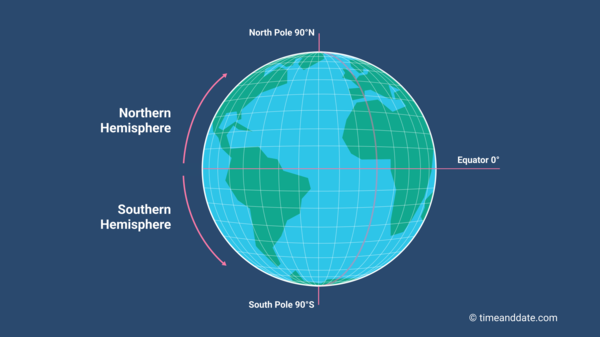

The Northern Hemisphere runs from 0° latitude to 90° North and the Southern Hemisphere from 0° latitude to 90° South.
©timeanddate.com
What Is the Northern Hemisphere?
The Northern Hemisphere is the northern half of the Earth. It begins at 0° latitude (the equator) and continues north until it reaches 90°N latitude (the North Pole).
What Is the Southern Hemisphere?
The Southern Hemisphere is the southern half of the Earth. It starts at 0° latitude and continues south until it reaches the 90°S latitude (the South Pole).
Northern Hemisphere Bias
Some differences between the Southern and Northern Hemispheres are literally polar opposite but tend to be portrayed from the perspective of the Northern Hemisphere.
One of the most misleading differences is that the calendar symbols for the Moon phases are based on the Northern Hemisphere point of view. For example, in the Northern Hemisphere the lit-up half of First Quarter Moon is on the right; however, in the Southern Hemisphere, it is the left side of the Moon that is illuminated at First Quarter.
The calendar Moon phase symbols are:= New Moon,
= First Quarter,
= Full Moon
,
= Third Quarter
Though there are differences, some things are almost the same in both hemispheres, albeit during opposite times of the year: When it is winter in the Northern Hemisphere, it is summer in the Southern Hemisphere. The Arctic and the Antarctic both have the midnight sun, polar nights, and the Northern and Southern lights (aurora boralis and australis).
One of the explanations for the bias can be that most of the world’s population lives in the Northern Hemisphere.

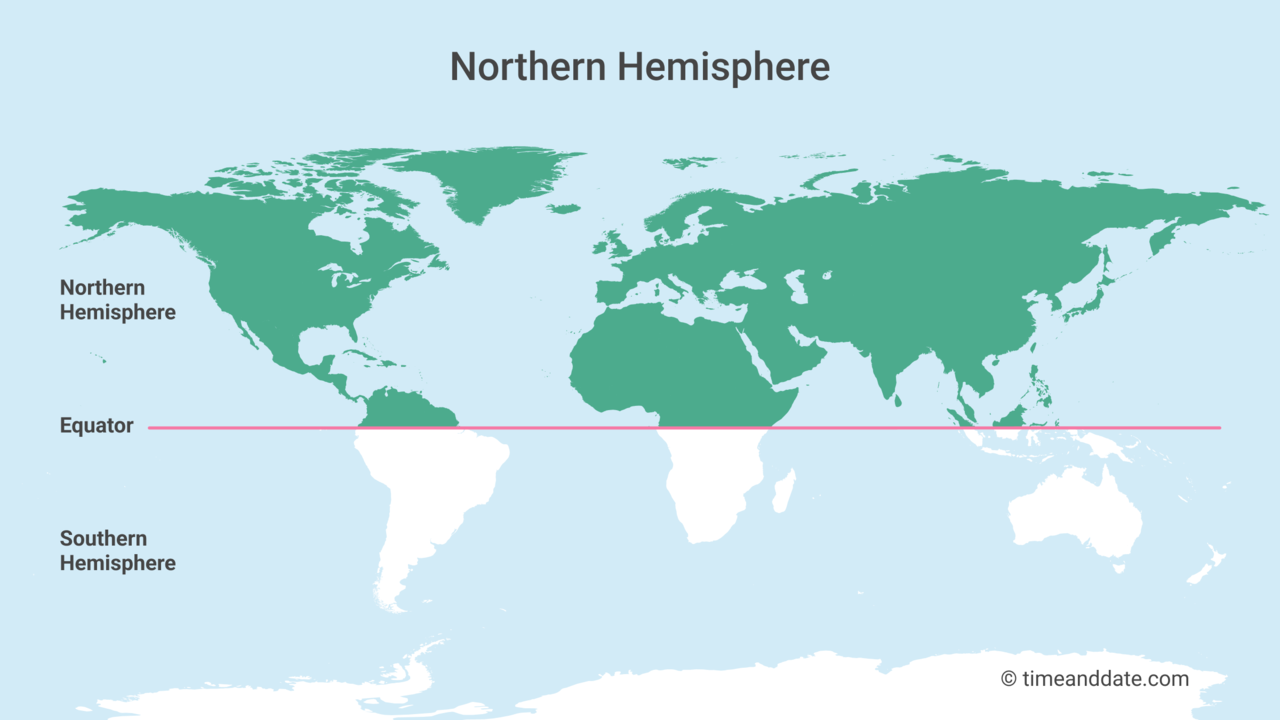
87% of the world’s population lives in the Northern Hemisphere. It has the largest portion of landmass on the globe.
©timeanddate.com
Most People in the Northern Hemisphere
According to timeanddate’s data, around 6.7 billion people live in the Northern Hemisphere: 87% of Earth’s population.*
What Is a Hemisphere?
Hemisphere (pronounced HEH-mih-sfear) is used to describe one half of a sphere—a round object—like a planet, or in this case, Earth.
The word is from the Greek hēmisphairion: Hēmi meaning ‘half’ and sphere coming from sphaira, meaning ball.
This is because this part of the globe has the largest landmass and contains many of the most populous countries, including China, India, and the US.
Five of Earth’s seven continents are either wholly or partly in this hemisphere, including all of North America and Europe, most of Asia, two-thirds of Africa, and the northern part of South America.
Four of the five World Oceans are present in the Northern Hemisphere: the Pacific, Arctic, Indian, and Atlantic Oceans.

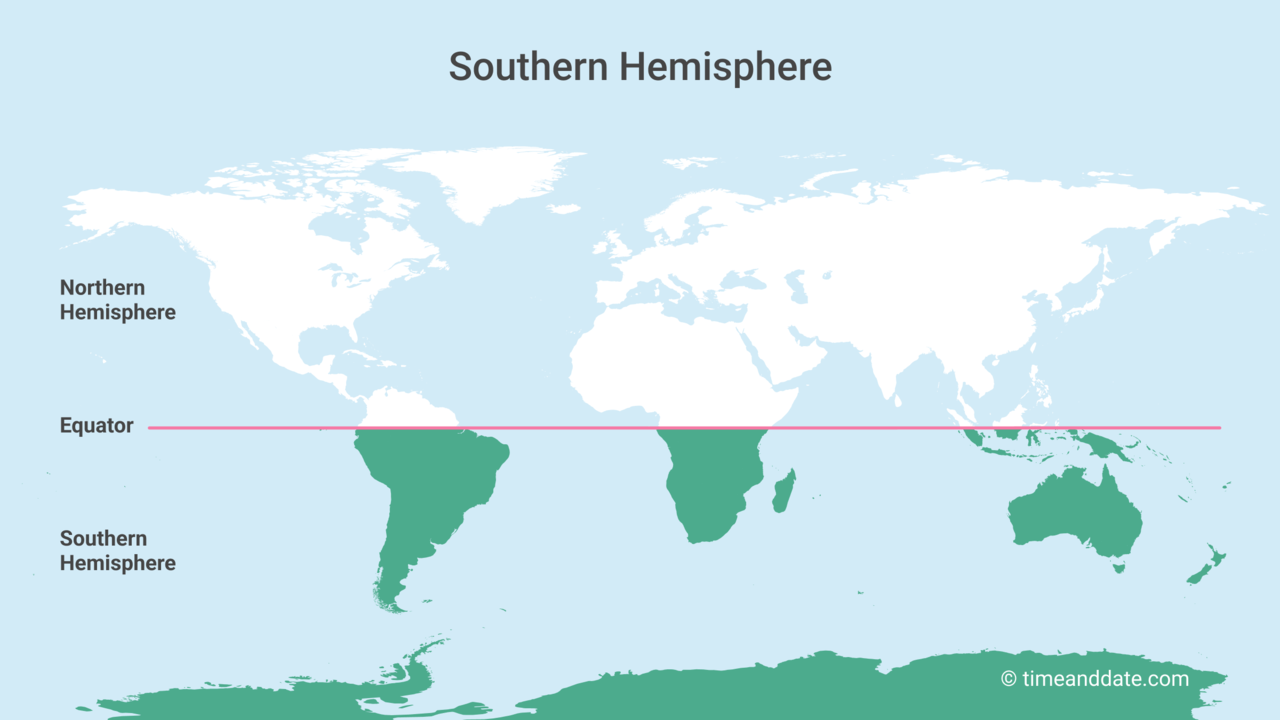
The Southern Hemisphere consists of more ocean than the Northern Hemisphere.
©timeanddate.com
More Ocean in the Southern Hemisphere
About 1 billion people live in the Southern Hemisphere: 13% of the world population.*
The continents Australia and Antarctica are located wholly in the Southern Hemisphere. Also, most of South America and one-third of Africa are in the southern half of the globe. The most populated country south of the equator is Indonesia, while Brazil is the largest country geographically. Traditionally, Australia and New Zealand have been considered more western countries in the Southern Hemisphere.
The Southern Ocean is the only Ocean that is located entirely in the Southern Hemisphere. Except for the Arctic Ocean, the other four—the Pacific, Indian, and Atlantic Oceans—are also present in the southern half of the globe.
Opposite Seasons in the North and South
Seasons in the Northern and Southern Hemispheres are opposite. When it is winter in the Northern Hemisphere, it’s summer in the Southern Hemisphere. This is because Earth’s axis is tilted in relation to its orbit around the Sun, known as axial tilt.
Unequal Seasons
Summers in the Northern Hemisphere are a few days longer than summers in the Southern Hemisphere.
This is because the Earth is slightly further away from the Sun in July than in December and moves more slowly in its orbit around the Sun.
Each Hemisphere tilts toward and away from the Sun at opposite times of the year, so when it is winter in the northern half of the globe, it is summer in the southern half and vice versa.
Astronomical spring in the Northern Hemisphere starts with the March equinox, summer with the June solstice, fall (autumn) with the September equinox, and winter with the December solstice.

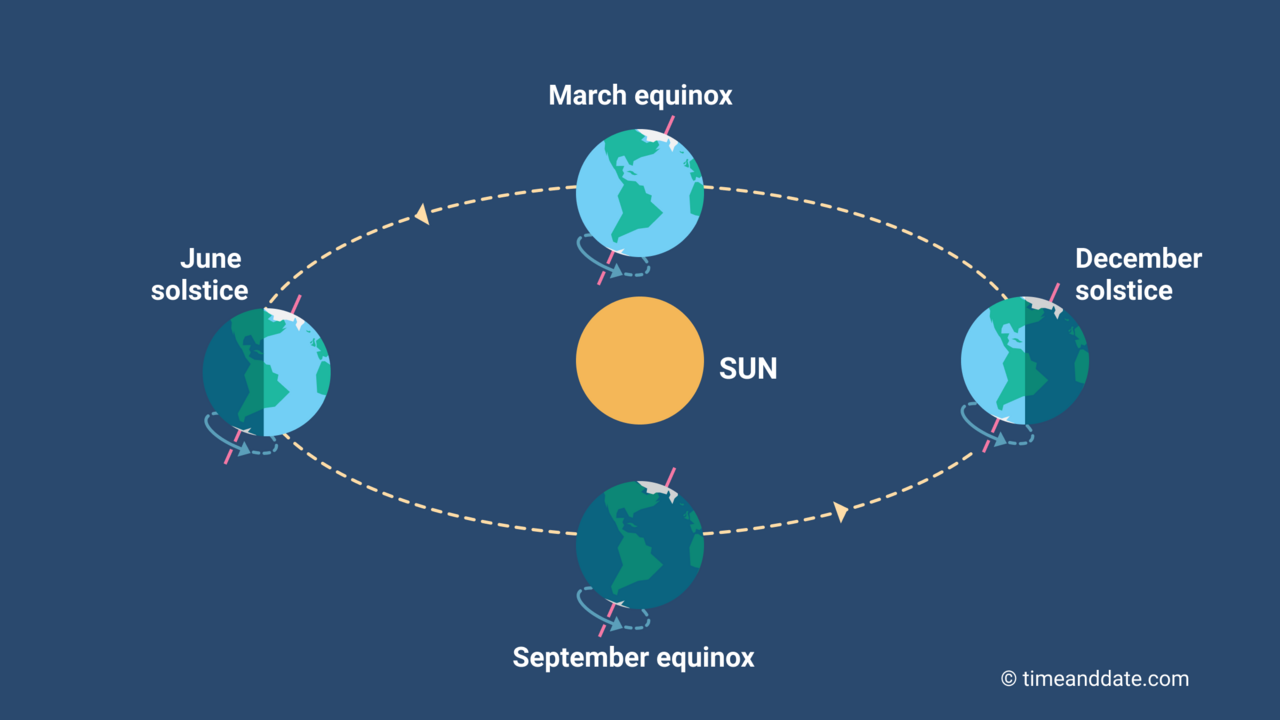
The Northern Hemisphere receives more sunlight between March and September than the Southern Hemisphere. Between September and March, the Southern Hemisphere receives more sunlight.
©timeanddate.com
The Moon & Sun’s Movement Across the Sky
The Sun and Moon’s movement across the sky is different depending on where you stand on the globe:
- In most of the Northern Hemisphere, the Sun and the Moon rise in an easterly direction and set in the west. Both move in the same direction across the southern sky.
- In the Southern Hemisphere, even though the Sun and the Moon also rise in the east and set in the west, they appear to be moving in the opposite direction as the Sun and the Moon move across the northern sky.
- Around the equator—roughly speaking—the Sun and the Moon rise vertically and pass directly overhead.
See the Sun rise and move across the sky in New York, US (hit play)
See the Sun rise and move across the sky in Sydney, Australia (hit play)
See the Sun rise and move across the sky Quito, Equador (hit play)
Moon Phases Look Different
We are all looking at the same Moon, but the most apparent difference between the Northern and Southern Hemisphere sky is the orientation of the lit-up side of the Moon as it goes through its phases:
- In most of the Northern Hemisphere, after New Moon, the terminator—the line separating the lit-up side and dark side of the Moon—moves from the right to the left. In other words, during First Quarter, the right half of the Moon is illuminated.
- Observers in the Southern and Northern Hemispheres are the opposite way round—imaginary lines running from their feet to their heads go in roughly opposite directions. Therefore, for a person in one hemisphere, the Moon appears ‘upside down’ compared to someone in the other hemisphere.
- Around the equator, the orientation of the illuminated part of the First Quarter Moon is the top half at moonrise and the bottom half at moonset.
Watch the First Quarter Moon over New York, US (hit play)
Watch the First Quarter Moon over Sydney, Australia (hit play)
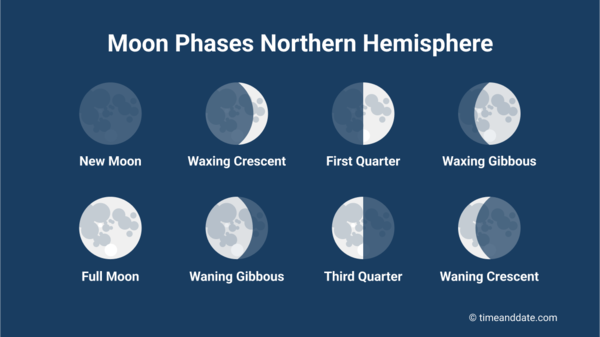

The orientation of the illuminated side of the Moon in the Northern Hemisphere. At First Quarter, the illuminated side of the Moon is on the right.
© timeanddate.com

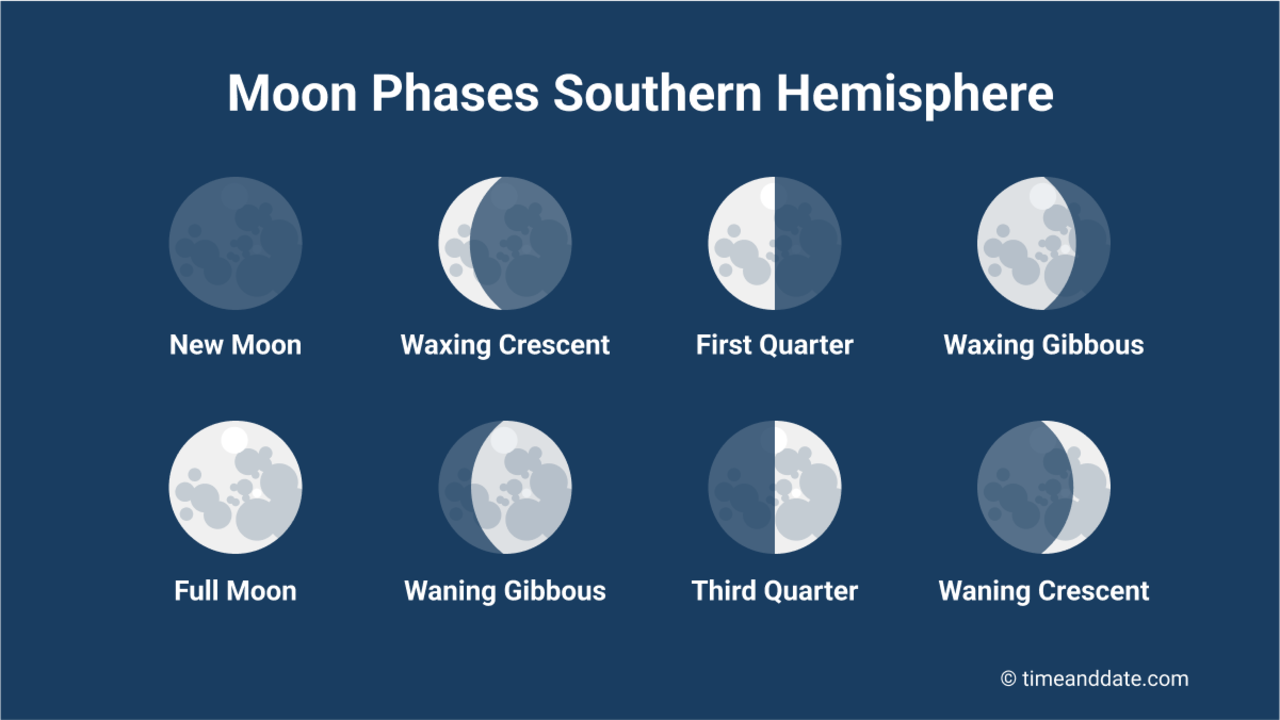
The orientation of the illuminated side of the Moon in the Southern Hemisphere. At First Quarter, the illuminated side of the Moon is on the left.
© timeanddate.com
The Night Skies Look Opposite
Just like the globe is divided into two Hemispheres, so is the night sky above the spheres. Generally speaking, the Northern and Southern Hemispheres look out into space in opposite directions. As with the difference between Moon phases, this is because observers in the Northern and Southern Hemispheres are standing ‘upside down’ relative to each other.
Because Earth is rotating, the northern and southern skies are ever-changing, but two stars are fixed: The North Pole is always pointing toward Polaris (the North Star), and the South Pole is always pointing toward Polaris Australis (the South Star). Generally speaking, the Southern Hemisphere tends to have better views of our galaxy: the Milky Way.
When we look at the planets in our solar system, they line up in different directions from the Northern and Southern Hemispheres. For example, in the alignment of the classical planets in June 2022, the planets line up from left to right as seen from New York, US, and from right to left if looking from Sydney, Australia.
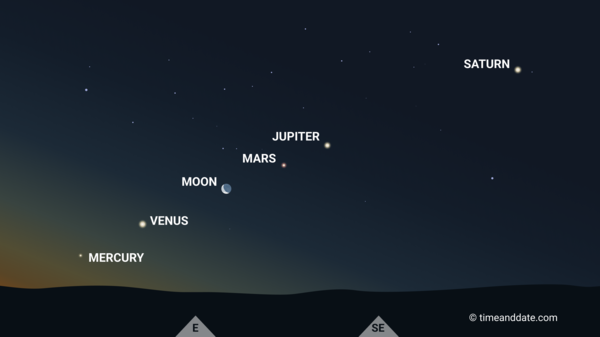
The planetary alignment from New York, US, in the Northern Hemisphere. The image is generated in our Night Sky Map at 04:40 local time (4:40 am) on June 24, 2022.
©timeanddate.com
Some meteor showers, including the Perseids, Draconids, and Quadrantids, are easier to view from the Northern Hemisphere.
*Our population data is calculated with data from the Socioeconomic Data and Applications Center (SEDAC).